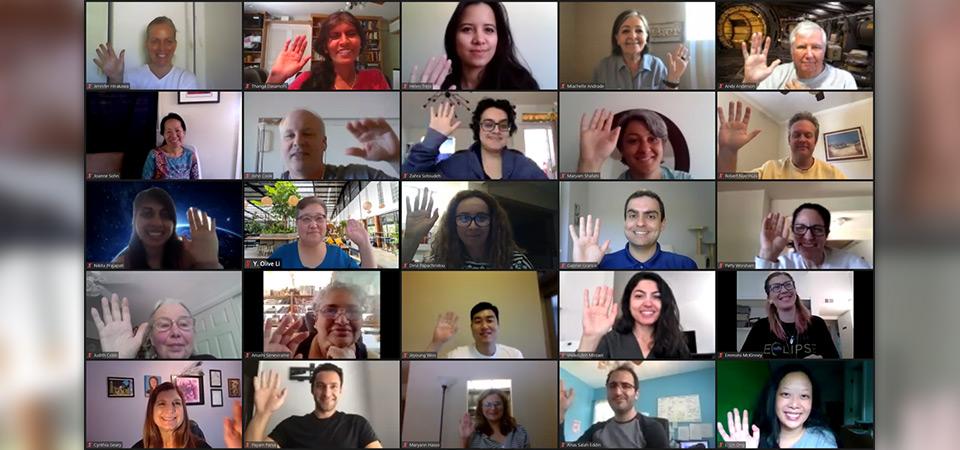Faculty Training for Remote Instruction Underway
Slideshow
This slideshow contains 1 slides that will change every 8 seconds. The first button is to play and pause the slideshow, followed by buttons to go to the previous slide, next slide, or choose individual slides.
When the coronavirus pandemic hit last spring and Cal Poly Pomona was forced to cancel in-person classes, faculty had just five days to adapt their courses to remote instruction.
The transition was easier for some more than others.
“For faculty who did not have experience teaching remotely, it was extremely stressful,” said Victoria Bhavsar, director of the university’s Center for the Advancement of Faculty Excellence (CAFE). “They had a tremendous amount to learn in a very short time.”
This summer, Cal Poly Pomona has embarked on a massive program aimed at training faculty in remote instruction for the fall semester. CAFE is assisting nearly 1,300 faculty members – nearly double the number of faculty that the center would normally interact with during the year.
The program focuses on designing remote courses. Faculty are placed into cohorts of between 35 to 45 people along rough disciplinary lines, Bhavsar said.
The training isn’t mandatory, but the university is making it available to all faculty members, who receive a stipend for it, she said.
“It’s a major undertaking. It’s not a short training,” said Bhavsar, who also is a soil science lecturer for the plant science department. “It’s a several-week involvement.”
Faculty learn the best practices for remote instruction, she added. They include:
- Alignment: making sure that learning goals, activities, graded work and learning technologies all pull together.
- Communication and social presence: having consistent, kind, and clear communication.
- Having a variety of activities to make online classes challenging, interesting and fun, to encourage student motivation and persistence.
Faculty are strongly encouraged to consider equity and inclusiveness as they design their courses, Bhavsar said.
“It’s an opportunity to rethink how you offer courses,” she said.
For example, streaming video for synchronous meetings requires a lot of bandwidth, which low-income students may not have.
“I don’t have strong Wi-Fi at home, so I relied on the school internet to do my homework and watch Zoom lectures,” said Phuc Nguyen, who graduated in plant science this spring. “A couple of weeks after everything shut down, I had to drive to school to get Wi-Fi and participate in a Zoom meeting.”
Although Nguyen was eventually able to get a mobile hotspot from the University Library with the help of one of her professors, faculty need keep their students’ access to resources in mind.
In addition, faculty are advised to be mindful of equity gaps in graduation rates and student persistence. They are encouraged use best practices that are known to support student success, including engaging with them on a regular basis.
Kim Miller, an associate professor and academic advisor for the agricultural science major, said some students struggled in the remote instruction environment at first.
“What worked well was staying on top of the struggles: watching Blackboard closely for assignment submission – or lack thereof – days and times that students were logging in and completing work, and – most important – communicating with my students,” Miller said.
“One of my best practices is to send out reminder emails about submission due dates and motivational audio messages to help the students stay on track throughout the semester,” she added.
The faculty training course is 100 percent “asynchronous” – meaning that faculty do the activities at their own pace, without class meetings for instruction. There are weekly optional “synchronous” meetings with training facilitators.
Many of the courses these faculty will teach in the fall are mixed synchronous and asynchronous. Some class meetings are replaced with purposeful directed online learning: students watch video lectures on a focused topic, read articles online or visit websites to gather specific information. When the students and instructors meet in class or “synchronous” instruction, they apply the information they gathered.
The training course also provides faculty with strategies with communicating and interacting with students in a remote or virtual environment.
In addition, faculty have tutorials on how to use Zoom, create videos, upload course assets to Blackboard and share them securely with their students, and how to use other resources like LinkedIn Learning.
A key concern is making remote instruction digitally accessible to students with disabilities, Bhavsar said. In collaboration with the Disability Resource Center and the Accessible Technology Initiative, CAFE offers best practices and resources to assist faculty in this area.
Additional sessions are offered on teaching to large classes, and activity and lab classes. The College of the Extended University in collaboration with Provost Sylvia Alva hired Ian A. Lubin, a learning design and technology consultant, to assist with sessions on large classes.
With so many faculty in training, students should have a better, smoother experience with Blackboard and Zoom this fall, Bhavsar said. But students also need to take ownership of their education, she said.
“If parents have students in college, please encourage their students to be active participants in their own remote education,” Bhavsar said. “Faculty are knocking themselves out to reach out to you to make that connection through their keyboards. So please participate.”

